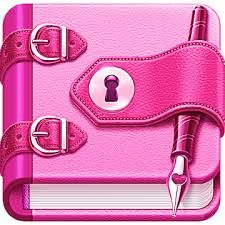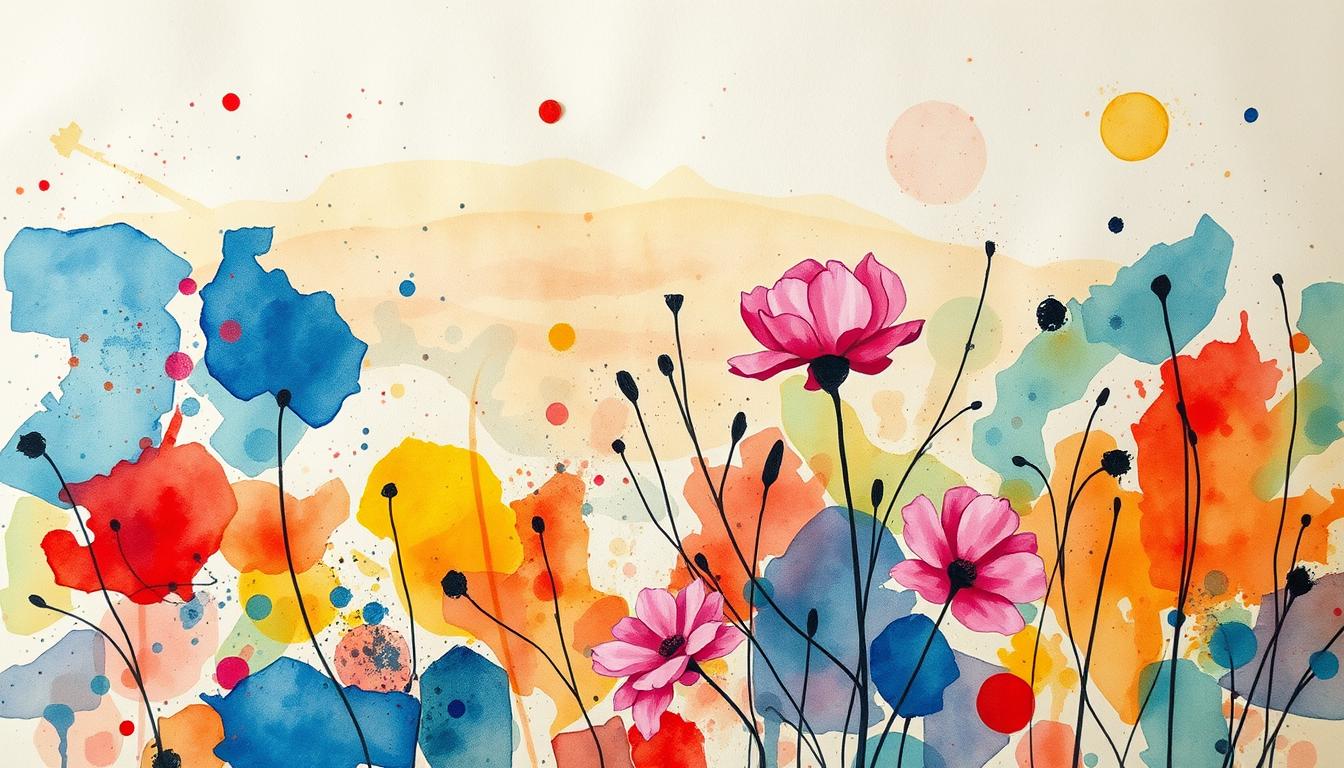Are you looking for a creative way to express yourself? Art journaling with watercolor could be the perfect start. Imagine turning blank pages into colorful masterpieces, where each brushstroke tells a story.
Watercolor is more than paint; it’s a magical medium that brings your journal to life. It creates soft, ethereal effects that capture emotions in a way other mediums can’t. Your journey into watercolor techniques will open up a world of artistic expression.
Whether you’re new to art or looking to mix media, this guide has you covered. We’ll cover watercolor’s unique properties, essential tools, and help you build confidence. Get ready to make your journal a canvas of personal stories.
Art journaling with watercolor is about exploration, emotion, and capturing moments. It’s not about being perfect. Let’s explore this colorful world together!
Understanding Watercolor Basics for Journal Art
Watercolor painting is a world of delicate yet powerful art. As a beginner, learning the basics will unlock your creativity. It turns your art journal into a vibrant canvas of personal stories.
What Makes Watercolor Unique
Watercolor painting is special because of its unique traits. Its transparent nature lets light pass through, making colors shine in a way other paints can’t.
- Translucent color layers
- Fluid and unpredictable movements
- Ability to create soft, blended washes
Properties of Watercolor Paint
Watercolor paint is made of pigments in a water-based binder. The quality of your paint affects your art. Professional paints have deeper colors and better color hold than student-grade ones.
“Watercolor is about embracing the unexpected and finding beauty in spontaneity.” – Unknown Artist
The Role of Water in Watercolor Painting
Water turns dry pigments into vibrant art. The water amount changes the painting’s look. Learning to use water well is key to mastering watercolor.
| Water Ratio | Paint Effect |
|---|---|
| High Water Content | Soft, transparent washes |
| Low Water Content | Intense, opaque colors |
| Moderate Water | Balanced, controlled painting |
Knowing these basics lets you confidently try new things. You’ll create stunning journal art that shows your unique vision.
Essential Supplies for Art Journaling with Watercolor
Starting your watercolor art journal journey requires the right supplies. As a beginner, focus on quality and affordability. You don’t need to buy everything at once. Start with the basics and add more as you grow.
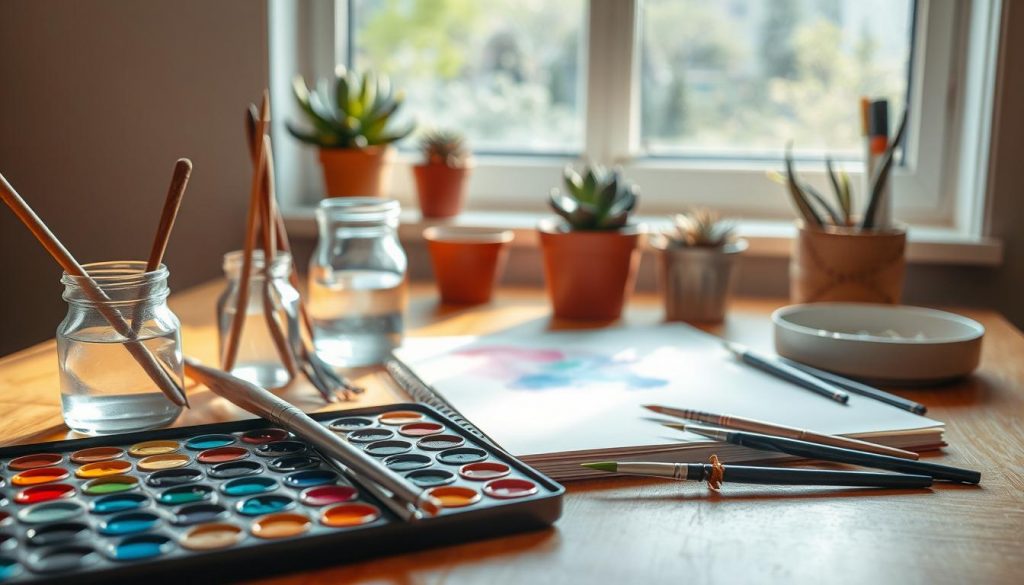
- A quality mixed media journal (Strathmore Mixed Media Art Journal recommended)
- Watercolor paint set (Winsor & Newton Cotman set, priced at ca $15)
- Brushes (da Vinci Watercolor Series set, around $35)
- Water container
- Paper towels or cloth
“The right supplies can transform your art journal from intimidating to inspiring.” – Art Journaling Expert
For paper, consider these weight recommendations for art journal ideas:
| Paper Weight | Suitability |
|---|---|
| 30-90 lbs | Beginner-friendly, lighter option |
| 140 lbs | Recommended for most watercolor projects |
| 300 lbs | Professional-grade, handles heavy water usage |
Budget-conscious artists can start with the SAKURA Koi Pocket Field Sketch Kit. It has 24 colors for about $19. You don’t need to spend a lot to create beautiful art journal pages!
Pro tip for beginner watercolor artists: Start with a simple palette and a few quality brushes. As you get better, you can add more supplies to your collection.
Choosing the Right Paper for Your Watercolor Journal
Finding the perfect paper is key for great journal decoration and mixed media journaling. The quality of your paper greatly affects your creative work. The right paper can make your art shine, while the wrong one can be a letdown.
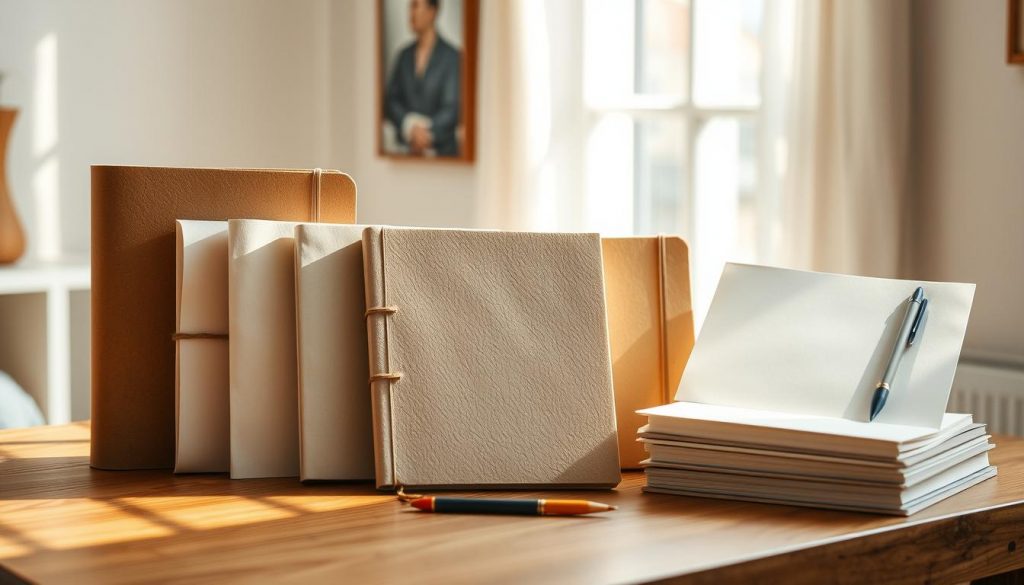
When you start watercolor journaling, knowing about paper is important. Not all papers are the same, and picking the wrong one can limit your creativity.
Paper Weight and Texture Insights
Paper weight is very important for your watercolor journal. Here are some things to think about:
- Recommended weight: 300 gsm (140 lb) for best watercolor absorption
- Texture options: Cold-pressed vs. hot-pressed surfaces
- Thickness matters: 180 g/m² or higher prevents warping
Top Journal Brands for Watercolor
| Brand | Paper Weight | Performance |
|---|---|---|
| Canson Mixed Media | 98 lb | Excellent wet media handling |
| Moleskine Watercolor Album | 135 lb | Premium watercolor performance |
| Ranger Dylusions | Thick cardstock | No bleed-through |
Paper’s Impact on Your Artistic Results
Your paper choice affects your watercolor art. Thin papers can bleed and warp. But, good mixed media papers offer:
- Better water absorption
- Minimal page buckling
- Enhanced color vibrancy
“The right paper is like a canvas for your imagination – it elevates your art from good to extraordinary.”
Invest in quality paper to reach your full creative ability in journal decoration and mixed media journaling.
Art Journaling with Watercolor: Techniques and Applications
Explore the world of creative techniques that make your visual diary come alive. Watercolor is a great way to express yourself, adding color and life to your journal pages.
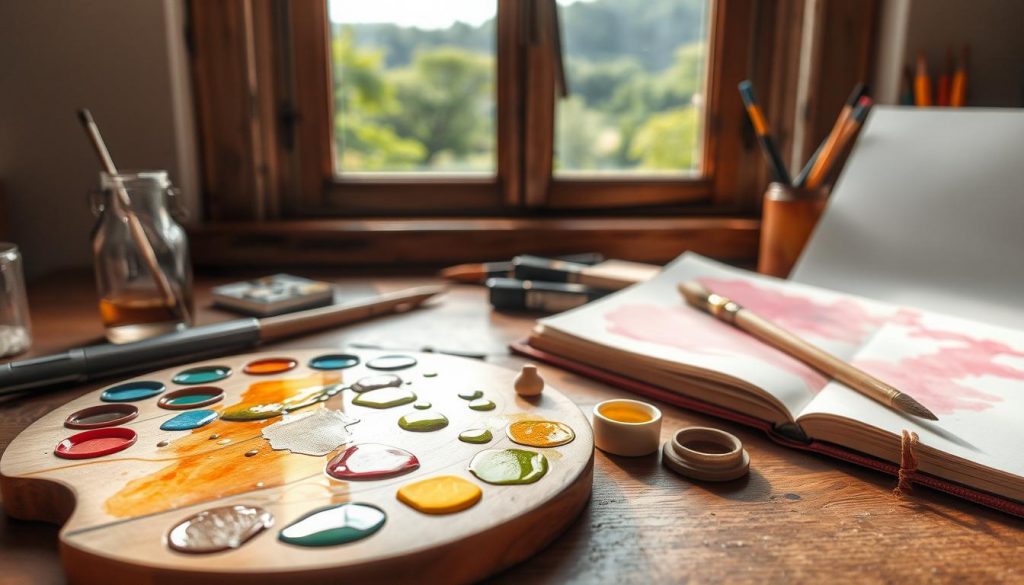
Discover these exciting watercolor methods to boost your artistic journaling:
- Wet-on-wet technique: Create soft, blended color effects by applying wet paint to a damp surface
- Wet-on-dry technique: Achieve crisp edges and more controlled color application
- Layering: Build depth by allowing previous layers to dry completely
- Paint lifting: Remove or lighten areas for unique texture and highlights
“Art journaling is about exploration, not perfection.” – Anonymous Artist
Mixed media can make your watercolor journal pages even more special. Try combining your watercolors with:
- Pen and ink drawings
- Collage elements
- Stamping techniques
- Ephemera like ticket stubs or postcards
| Technique | Effect | Difficulty Level |
|---|---|---|
| Wet-on-wet | Soft, blended colors | Beginner |
| Layering | Depth and dimension | Intermediate |
| Mixed Media | Textural complexity | Advanced |
Did you know 75% of art journalers say it helps them get past creative blocks? Start trying out these techniques and see your creativity grow!
Watercolor Brushes and Tools for Journal Artists
Choosing the right brushes can change how you enjoy art journaling. Watercolor painting needs special tools. These tools help you make your art journal prompts come alive with precision and creativity.
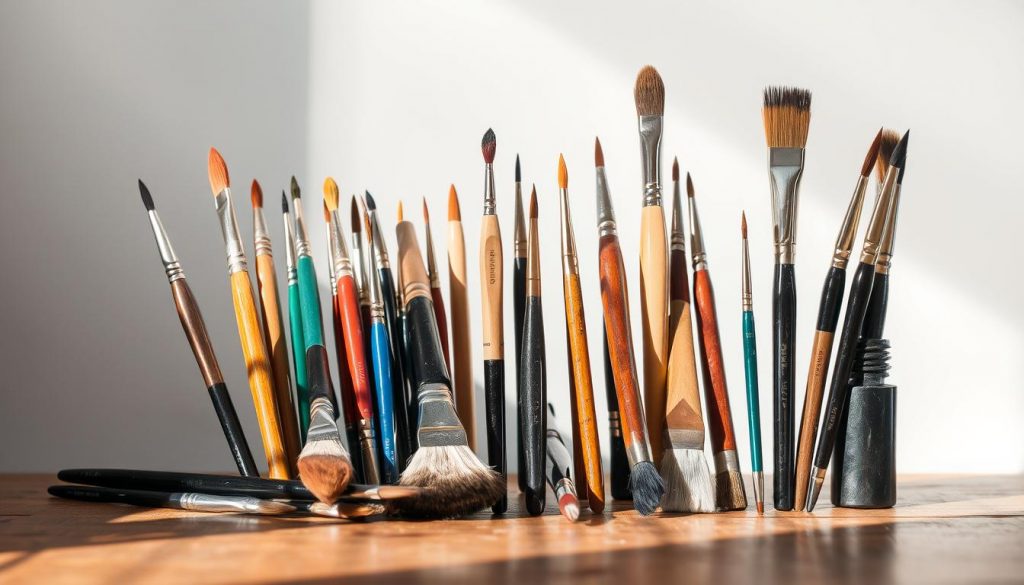
Essential Brush Types for Unique Effects
Each brush type gives you different painting tips for your watercolor journal. Professional artists suggest these main brush types:
- Round brushes (#4 and #6 sizes) for versatile painting
- Pointed brushes for detailed work
- Flat brushes for wide washes
- Quill brushes like Raphael SoftAqua #3/0 for fine details
Water Brush Pens: Your Portable Journaling Companion
Water brush pens make art journaling easier and more portable. They mix a water reservoir with a paintbrush tip. This makes them great for sketching anywhere.
“Creativity knows no boundaries with the right tools in hand.” – Watercolor Artist
Maintaining Your Watercolor Tools
Good brush care keeps them lasting longer and working better. Rinse them well after use, shape the bristles, and store them flat or hanging. This keeps their shape.
| Brush Brand | Number of Brushes | Price Range |
|---|---|---|
| Winsor & Newton Cotman | 4 | ca $19 |
| Princeton Select Artiste | 5 | ca $15 |
Invest in quality brushes to spark your artistic journey. They help you discover new creative paths in your art journal.
Color Theory and Mixing Watercolors in Your Journal
Color theory changes how you create in your watercolor journal. Begin with the color wheel, which has three main colors: red, yellow, and blue. Learning how these colors work together opens up new ways to make your journal pages pop. Using 6-12 colors helps you mix without getting too complicated.
Try mixing primary colors to make secondary and tertiary shades. For example, warm blue and yellow make teal. Red and blue mix to create purples or eggplant shades. Making a color mixing chart helps you see how colors work together.
Getting good at color theory takes practice and curiosity. Try wet-on-wet painting for smooth color blends. Also, play with color temperatures. Watercolor mixing is about trying things out, not just following rules. Your journal is a place to find new color combinations that show your unique style.
Begin with 8 colors for your first palette. This makes choosing colors easier and keeps your art looking good. Enjoy the learning journey. Every brushstroke helps you get better at mixing colors and documenting your creativity.
FAQ
What makes watercolor different from other painting mediums?
Watercolor stands out because it’s transparent and interacts with water in a special way. Unlike acrylic or oil paints, it lets light shine through, creating bright and soft effects. The way water moves and mixes on paper makes each piece unique.
Do I need expensive supplies to start watercolor art journaling?
No, you don’t need to spend a lot to begin. Start with student-grade watercolors, basic brushes, and a sketchbook. Winsor & Newton Cotman, Sakura, and Arteza offer affordable sets for beginners. Focus on learning first, not on buying expensive stuff.
How important is the type of paper I use for watercolor?
Paper is very important for watercolor art journaling. Look for paper that’s at least 140 lb weight and made for watercolor. Cold-pressed paper has texture, while hot-pressed is smooth. Moleskine, Strathmore, and Canson are great for beginners.
What basic techniques should I learn first?
Start with two key techniques: wet-on-wet and wet-on-dry. Wet-on-wet blends colors softly. Wet-on-dry gives you control and sharp edges. Practice these to see how water and paint work together.
Can I combine watercolor with other art materials?
Yes! Mixing watercolor with other materials is a great way to add depth to your art. You can use ink pens, colored pencils, washi tape, and more. Watercolor’s translucent base is perfect for layering.
How do I mix colors effectively in watercolor?
Knowing color theory is essential. Learn about primary colors and how they mix. Use a color wheel for reference. Practice mixing on a palette before adding to your journal. Remember, colors dry lighter than they look wet.
What’s the best way to care for my watercolor brushes?
Rinse your brushes well, reshape the tip, and dry them horizontally. Avoid standing them in water to prevent damage. Clean them gently with mild soap to keep them in good shape.
How can I improve my watercolor skills?
Practice every day and be open to trying new things. Use art journal prompts, watch tutorials, and take classes. Watercolor is about being spontaneous and learning from mistakes. Keep a journal for technique practice and you’ll get better over time.
Source Links
- How to Paint With Watercolor: A Beginner’s Guide to Watercolor Basics
- How To Start A Travel Journal Or Paint Journal Or Sketch Journal – Cindy Briggs Art
- Bible Journaling Video Tutorial: Watercolor Tips for Beginners
- From Art Journal and Beyond
- Art Journaling for Beginners | Bliss Arts Co.
- Watercolor Art Journaling 101: The Essential Supply List — A painted page
- Art Journaling Supplies — Lauren Leone
- Must Have Mixed Media Supplies for the Art Journal – Hop-A-Long Studio
- Best Paper For Art Journaling – What Works And What Doesn’t
- What paper or drawing pad or art journal should I use for art journalling?
- What is the Best Journal for Art Journaling? | Fox + Hazel
- Art Journaling 101
- How To Create an Easy Watercolor Art Journal Page | Page Flutter
- Affordable Watercolor Supplies for Beginner-Intermediate Levels
- A Watercolor Kit for Journals
- Intimidated by Watercolor Mixing? An Easy Watercolor Tutorial – Hop-A-Long Studio
- How To Mix Watercolors – Essential Guide
- Nature journaling with cheap watercolors? – Marley Peifer
